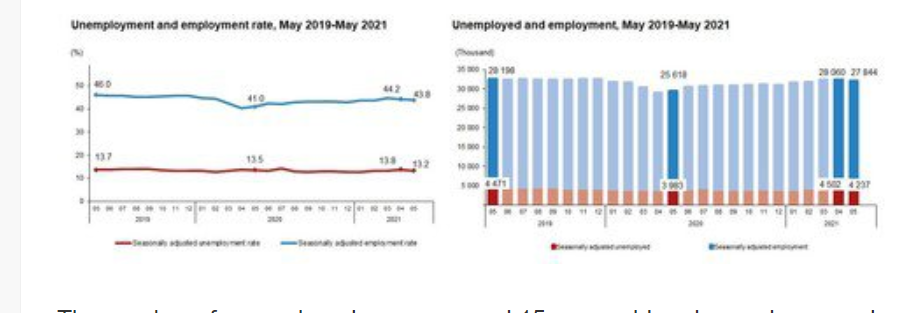The unemployment rate in May was 13.2 percent in Turkey. The data shows that the number of people employed decreased in May, but unemployment rates are still falling.
In an environment where trust in the management of the Turkish Statistical Institute has decreased due to political influence, the institution decided to release monthly employment data instead of quarterly averages. While this change made it difficult to make comparisons, the temporary employee dismissal ban and short-time working allowance implemented due to the pandemic made reding employment data more complex.
It is also clear that the controversial labor force statistics are making the data not indicative. That is why, as we saw in the last May data, despite the decrease in the number of employees, there is a decrease in unemployment rates as the outflows from the labor market increased more.
WATCH: Real Turkey featuring Mehmet Ogutcu: World after the pandemic—where does Turkey fit in?
The number of people employed decreased by 216 thousand people in May 2021 compared to the previous month to fall to 27 million 844 thousand people, while the employment rate fell by 0.4 points to 43.8 percent. The workforce fell by 481 thousand people in the same month compared to April, declining to 32 million 81 thousand people, while the labor force participation rate decreased by 0.8 points to 50.5 percent. As a result, the headline unemployment rate dropped to 13.2%.
WATCH: Turkish Economy IS in Crisis | Real Turkey
The unemployment rate among the young population between the ages of 15-24 was 24 percent, witnessing a decrease of 2 percentage points compared to the previous month, and the employment rate became 31.9 percent with an increase of 0.1 percentage points. The labor force participation rate in the subject age group decreased by 1.1 points compared to the previous month to 41.9 percent.
The rate of idle labor force consisting of underemployment, those temporarily “out for work force” (waiting to be re-hired), and the unemployed decreased by 0.2 percentage points compared to the previous month and became 27.2 percent in May 2021. Even this rate, known as broadly defined unemployment, appears to have fallen as employment participation has declined.
Despite the harsh reality of mass unemployment experienced across the nation, reporting ambiguities in all aspects of the employment figures of TURKSTAT inevitably increase the distrust of these data among the public. That is why concerns about inaccuracy or deliberate correction methods of TurkStat and the data received are on the rise.
Despite the complexity of TURKSTAT’s data, the words of former Treasury Undersecretary Faik Öztrak, CHP Deputy Chairman and Party Spokesman, actually reveal the reality. In his social media post, Öztrak reminds us that the real unemployment rate was 16.2 percent in the last three years after the transition to the presidential system, while it was 27.2 percent in May. He states that the number of unemployed has increased from 5 million 528 thousand to 9 million 671 thousand in the last three years, and increased by 4 million 143 thousand people in the three years we spent in the presidential system.
It is tough to make predictions as employment data ceases to be an indicator. Some suggest that the actual picture could be become clear once working allowances and dismissal ban applications get abandoned. However, some predictions suggest that there would be considerable increases in the unemployment rate when businesses have the freedom to sack.
When we look at May, an increase in unemployment rates expected due to the closures and public holidays. Practices such as short-term working grants and dismissals had a positive impact on employment rates in May. Based on this fact, the decrease in unemployment rates will continue with the data to come in June, which is not a long holiday when partial openings begin.
Employment numbers are precited to rise as of July. Because the services sector, which bears a burden on employment rates, reached its peak as of July. In addition, the opening of tourism from the beginning of July will make a significant contribution to the employment rate.
So, what will businesses do now that they have not fired due to the incentives applied during the pandemic? As we have seen at Turkish Airlines, layoffs are inevitable. However, it is fair to expect that the additional employment to be created from July will be more than the layoffs, which will prevent the increase in unemployment rates. However, it seems likely that the improvements in unemployment rates will continue to increase in the coming period.
Data and calculations on the relationship between employment and productivity are also mixed. When looked at the current employment data, it is now challenging to estimate social security institutions’ income statement and create a projection for the decreasing unemployment fund. Applications for welfare payments are no longer valid, and some of those who got rejected due to their applications will not benefit from the unemployment fund. However, there will be grievances in the retirement accounts in the future because insurance premiums are not getting paid.
Source: Cumhuriyet.com.tr
Translation: Cem Cetinguc
Follow our English language YouTube videos @ REAL TURKEY: https://www.youtube.com/channel/UCKpFJB4GFiNkhmpVZQ_d9Rg
And content at Twitter: @AtillaEng
Facebook: Real Turkey Channel: https://www.facebook.com/realturkeychannel/
